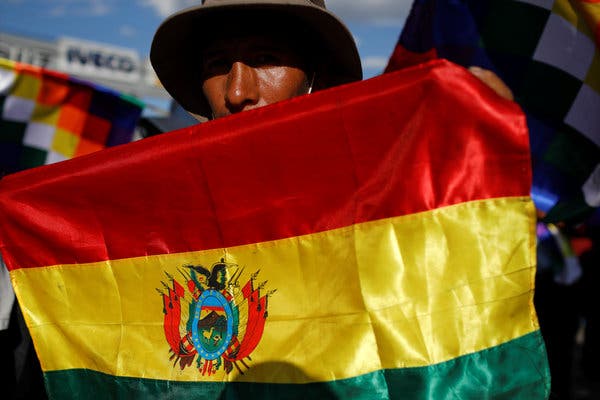
After the Bolivian military forced out Evo Morales as president last month, following a wave of demonstrations protesting fraud in his fourth presidential election, the right-wing Catholic politician Jeanine Añez Chavez, second vice president of the Bolivian Senate, was deemed next in the line of succession and sworn in as his replacement.
Ms. Añez pledged to "bring back democracy and tranquillity," but she instead embarked on a blatantly revanchist, ruthless path, stacking her cabinet with religious conservatives bitterly opposed to Mr. Morales's Movement for Socialism, breaking ties with the left-wing governments of Cuba and Venezuela and dispatching an ambassador to a gleeful Trump administration, the first in Washington in 11 years.
She issued a decree exempting security forces from criminal prosecution when maintaining public order; the following day, eight protesters were killed in a lethal crackdown, and more have been killed since.
At the same time, Mr. Morales's legions of Indigenous followers sealed off access to their region, where he comes from, with scores of barricades and vowed to give the government no peace until he returns.
Mr. Morales became Bolivia's first Indigenous leader when he was elected 14 years ago, breaking the monopoly on power of a small elite of European descent. He sharply reduced the poverty rate, expanded the economy and helped introduce a new, more equitable constitution.
Then he overreached, calling a referendum in 2016 to lift constitutional term limits he himself had supported and, when the vote went against him, getting a Constitutional Court filled with his followers to rule that term limits violated his human rights.
The flawed election on Oct. 20 followed. Early suspicions of fraud by the Organization of American States helped fuel the protests and provided cover for the military to "suggest" that Mr. Morales leave office.
Last week the O.A.S. issued an audit, to which Mr. Morales had agreed, substantiating those suspicions and finding "a series of malicious operations aimed at altering the will expressed at the polls" on Oct. 20.
The Bolivian legislature has passed a law, with support from Mr. Morales's party and signed by Ms. Añez, paving the way toward new elections within a few months, with Mr. Morales barred from running.
Mr. Morales, who is now in Cuba, has agreed to renounce his candidacy, though he continues to claim, as he told The Guardian newspaper, "I have every right to it."
Renouncing any candidacy is the right way for him to help restore peace and democracy in a country for which he has done so much. There is no clear successor on the left, so Mr. Morales should focus on finding a worthy successor in his party who could hold off an inevitable challenge from the far right.
Ms. Añez, for her part, can make clear that her dubious leap from obscurity was not the coup that her opponents claim it was by abandoning her vindictive policies and fulfilling her promise to arrange a free and fair election. Anything less would mark a sad relapse to the era of serial coups and counter-coups that ravaged Bolivia, often with the clandestine participation of the C.I.A.
A continued standoff would only exacerbate the country's deep ethnic and ideological polarization. Mr. Morales's fall thrust Bolivia into the center of a left-right struggle convulsing much of the Americas. Seeing that resolved through the democratic process, rather than outside meddling, should be the goal of the United States and Bolivia's Latin American neighbors.
The Times is committed to publishing a diversity of letters to the editor. We'd like to hear what you think about this or any of our articles. Here are some tips. And here's our email: letters@nytimes.com.
Follow The New York Times Opinion section on Facebook, Twitter (@NYTopinion) and Instagram.